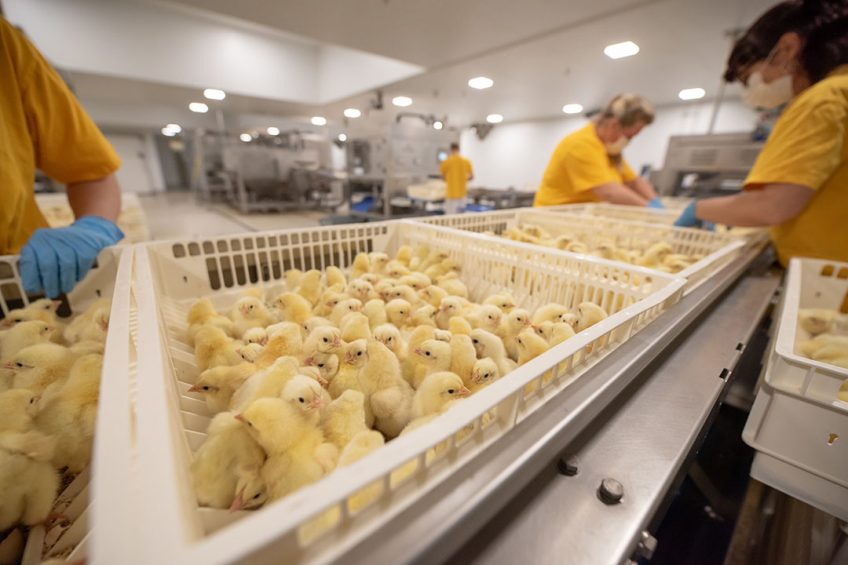Meta-analysis: Can PHFWD harm poultry development?

Delayed access to food and water after hatching causes weight loss in chicks during holding, mainly due to dehydration and utilisation of the yolk. A ‘meta-analysis’ was performed to determine effects of post-hatch food and water deprivation (PHFWD) on chicken development, performance and welfare.
In commercial hatcheries, chickens and poults usually hatch over a period of 24-48 hours. Newly-hatched chickens remain in the incubator until almost all have hatched, after which all chickens are collected. This is usually performed at day 21.5 of incubation (broilers and laying hens). After collection, also termed ‘pulling’, the chickens undergo hatchery treatments, such as selection of second-grade chickens, vaccination, sex determination and/or sorting. Thereafter, chickens are transported to the farm. From the moment of hatching until placement at the farm, food and water is usually withheld. The duration of this period depends on the hatch window, hatchery treatments and transport duration. The time until first food and water intake, known as the holding period, may take up to 72 hours where long transportation distances are involved. Chickens have been considered to be able to survive on the yolk sac reserves for a period of up to approximately 72 hours after hatching. However, while the yolk sac reserves may be sufficient for survival, it can be disputed whether or not all requirements have been met during the first 72 hours post-hatching. Post-hatch food and water deprivation (PHFWD) may have long term negative consequences for chicken welfare, and that their behavioural and physiological requirement for food and water may not be met under current commercial conditions.
Meta-analysis setup and results
In recent decades, studies have examined the effects of PHFWD on chicken performance, development and welfare. However, these studies have provided ambiguous results and a more quantitative (meta-) analysis of existing data is lacking. This study aimed to identify and quantify the measurable impacts of PHFWD on the development, performance and welfare of (especially broiler) chickens based on (the statistical analyses of reported experiments in) the existing scientific literature.
2 types of meta-analysis were performed on peer-reviewed publications:
- a quantitative ‘meta-analysis’ (MA)
- a qualitative analysis (QA).
Previously reported effects of PHFWD were quantified in the MA, for variables related to performance, mortality and relative yolk sac weight. The QA counted the number of studies reporting (non-)significant effects when 5 or more records were available in the data set.
Papers used for the MA were distinguished into 2 categories;
- papers in which chickens were deprived of both food and water after hatching (FW) and
- papers in which chickens were deprived of food only (FO) (while water was provided) after hatching.
Prolonged duration of PHFWD resulted in lower body weight at day 7, 21 and 42 compared to early fed chickens. Food intake from day 0 to 7, day 0 to 21 and day 0 to 42 was lower after 48 or more hours of PHFWD compared to early fed chickens (0 hours of PHFWD). FCR between day 0 and 7 was not affected by PHFWD, whereas it was higher between day 0 and 21 and between day 0 and 42 after ≥84 hours of PHFWD compared to 0 hours of PHFWD. Mortality between day 0 and 7 was higher after ≥ 84 hours of PHFWD compared to 0 hours of PHFWD. Mortality between day 0 and 21 was not affected by duration of PHFWD and mortality between day 0 and 42 was higher after 48 hours of PHFWD compared to 0 hours of PHFWD. A significant interaction was found between food and water deprivation type (FW/FO) and duration of PHFWD for relative yolk sac weight at three days of age (P<0.001). chickens deprived of both food and water (fw) for 72 hours had a lower relative yolk sac weight than 0 hours phfwd chickens, whereas in chickens deprived of only food (fo) the opposite was found.>
Physiological variables of PHFWD
Relative yolk sac weight: At approximately day 18 of incubation, the remaining part of the yolk, which has not yet been utilised, is absorbed into the abdominal cavity. This residual yolk provides immediate nutrition for maintenance and growth after hatching. During the first days post hatching, the chick makes the transition from utilising energy in the form of yolk lipids to exogenous carbohydrate-rich food. It has been suggested that in the presence of food, the major route of yolk utilisation is via the yolk stalk into the small intestine, whereas in case of PHFWD, yolk is mainly resorbed directly into the blood via the yolk-sac membrane. Thus, early post-hatch feeding may stimulate yolk sac resorption in the intestine, although studies also found that early post-hatch feeding did not stimulate yolk sac resorption.
Relative organ weights: Relative organ weights are usually assessed in poultry as indicators of physiological development. Several studies have reported effects of PHFWD on the relative weights of digestive organs of the chicken, such as the intestines, liver, proventriculus, gizzard and pancreas. It can be speculated that PHFWD retards the growth of digestive organs.
Intestinal development: In newly hatched chickens, the gastrointestinal tract is immature, but develops physically (e.g., weight and length), morphologically (villus height and area, maturation of enterocytes and goblet cells, organisation and establishment of the crypt region), and physiologically (e.g., enzyme activity and absorptive capacity) in the first weeks of age. According to the QA, several records indicated a negative effect (numerically lower values) of PHFWD on duodenal, jejunal and ileal length, but no long-term effect was found. Villus height at week 1 or 2 of age was lower in some studies after PHFWD compared to immediately fed chickens, whereas lower crypt depths were mainly found for jejunum in the first weeks of life. However, some positive effects (higher values) of PHFWD on intestinal development were also observed and several studies failed to indicate any effect. It has been suggested that PHFWD can be more influential in the development of certain intestinal segments. The effects of PHFWD on intestinal development appear to be transient. This does not mean that secondary effects (resulting from impaired digestion or absorption capabilities, e.g., impaired body weight gain) can not be long-lasting.
Timing of voluntary post-hatch food and water intake: Under natural conditions, when chickens are raised by a mother hen, the first food eaten by the chick will be offered to it by the mother hen. In the absence of a mother hen, newly hatched chickens peck indiscriminately at non-food and food objects, starting as early as a few hours after hatching. At three days of age pecks are directed primarily at the food. From hatching until day 3, the pecking behaviour of newly-hatched chickens seems to be independent of the nutritional state. By pecking at edible and non-edible objects, chickens learn to discriminate between food and non-food objects. If so, this would seem to imply that food intake is rewarding to newly-hatched chickens, thus suggesting that early food intake may improve bird welfare despite the fact that perhaps PHFWD may itself not be directly having a negative effect on welfare (i.e. pecking behaviour being independent of nutritional state). Newly-hatched chicks show an innate response to peck at shining objects and appear to seek out where to find water. They also recognise drinking behaviour of other chickens and are attracted to it. These studies, performed in non-commercial breeds or jungle fowl, again seem to suggest that the early provision of water would enhance chick welfare.
It remains unclear whether or not PHFWD actually reduces welfare, due to the unfulfilled behavioural and physiological need for food intake post-hatch. A single study showed more chicks jumping and displaying active wakefulness and fewer chicks displayed sitting behaviour as duration of PHFWD increased. This was interpreted as an increased searching motivation for food and water in chickens subjected to a longer period of food deprivation. This finding may indicate reduced welfare (stress or frustration) despite the earlier suggestion (no adverse welfare impact) related to the finding that pecking is independent of nutritional state.

Short term effects noted
The MA showed that PHFWD for 24 hours (i.e. ≥12–36 hours) resulted in significantly lower body weights compared to early fed chickens up to six weeks of age. Body weights and food intake were reduced more as PHFWD durations (24, 48, 72, ≥84 hours) increased. However, it is unclear whether or not effects of PHFWD on body weight are due to impaired development or to a delayed onset of growth. FCR at 21 and 42 days of age was increased from 48 hours PHFWD onwards. Although single studies did not find effects of PHFWD on mortality, the MA showed that 48 hours PHFWD leads to significantly higher total mortality at six weeks of age than 0 or 24 hours PHFWD.
The QA results indicate a transient negative effect of PHFWD on the development of the liver and the pancreas, and that PHFWD may delay the development of the duodenum, jejunum and ileum. These effects were observed mainly in the first week of age. Short term (potentially adverse) changes in plasma T3 and glucose concentrations were also found. It is concluded that 48 hours (≥36–60 hours) PHFWD leads to lower body weights and higher total mortality in chickens up to 6 weeks of age, the latter suggesting compromised chicken welfare, but effects of PHFWD on organ development and physiological status appear to be mainly short-term.
This article is based on the research paper ‘A ‘meta-analysis’ of effects of post-hatch food and water deprivation on development, performance and welfare of chickens’ published on PlosOne.












